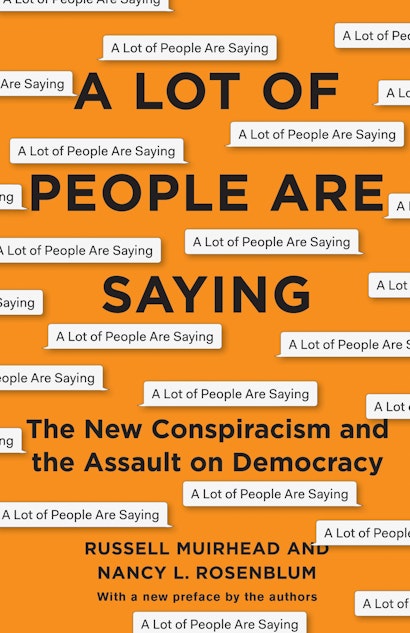Two years ago, we put the final revisions on our book about conspiratorial thinking in American politics: A Lot of People are Saying: the New Conspiracism and the Assault on Democracy. As we were about to click “send” and transmit the manuscript to Rob Tempio, our editor at Princeton University Press, we paused and asked each other, “what if everything we’ve studied has disappeared when the book comes out?”
We need not have worried about our book, for none of our fears for the country have been put to rest. American politics has been deranged and degraded by the forces we identified, chief among them a conspiracy-minded president who has the capacity to impose his compromised sense of reality on the nation.
We chart the move away from conspiracy theory to conspiracy without the theory, where conspiratorial allegations take the form of bare assertion, or innuendo, or “I’m just asking questions.” This is a radical and consequential shift. Instead of conspiracy theory as theory, as explanation (sometimes true!), we face a steady torrent of conspiracy claims that dispense with evidence and argument, with the dots and patterns that reveal covert, malignant intent.
Just one word —“rigged!” or “witchhunt!”—suffices to generate assent from cynical or supine Republicans in office and retweets and likes from citizens who affirm these charges and whose personal identities are tied up in the hostilities and aversions behind them. Conspiracy claims are validated by repetition. If they are not literally true, they are “true enough,” because conspiratorial fictions get at what followers take to be the deep truth of a cabal of powerful elites. And conspiracism’s aggressive violation of the rudiments of reasoning is itself proof that the President is a fearsome protector of his followers’ real interests.
Here are the two sure signs of this conspiracism:
- Our own disorientation. Conspiracism’s wild concoctions defy common sense. Pizzagate and now QAnon not only dispense with argument, they are fictions that don’t even refer to actual events. There is nothing to be explained. They insult both knowledge and reasonable skepticism. We are turned around and upside down by the unbridgeable divide conspiracism creates about what it means to know something.
- Delegitimation of foundational democratic institutions. Delegitimation is more than distrust: conspiracist attacks strip these institutions (and the experts and civil servants who make them run) of all meaning, value, and authority.
Democratic decision making requires knowledge-producing institutions, and it is exactly these that conspiracists delegitimate. These include intelligence services, scientists at the Environmental Protection Agency and the Centers for Disease Control, economists at the Bureau of Labor Statistics. Conspiracism denies the authority of journalists who rely on responsible sources and who are open to self-correction. Partisan conspiracism converts reasonable democratic skepticism about the privileged authority of experts into a crude wholesale claim that they are a malignant political force.
Just as important is the delegitimation of the defining institution of democracy: the regular rivalry of political parties where each acknowledges the legitimacy of the opposition. Today, Democrats are cast as “scum,” “traitors,” instigators of “coups” to undermine the President and weaken the nation. The opposition is allied with “anarchists, agitators, rioters, looters, and flag-burners.” They are not to be opposed but eliminated – “locked up,” or something more ominous still.
All this began with and is now culminating in attacks on elections as “rigged.” Trump began spreading this notion of a plot against him during the 2015 campaign. He went on to have the distinction of delegitimating an election he won, because he could not accept the reality that he lost the popular vote. So he invented three million fraudulent voters organized by Democrats or George Soros.
“Rigged!” returned after losses in the 2018 midterms. President Trump asserted, “There were a lot of close elections that were—they seem to, every single one of them went Democrat. If it was close, they say the Democrat—there’s something going on, fella …”
And today, he and his enablers in the Republican party deliver charges of a rigged election in anticipation of the vote. On opening day of the Republican convention Trump was adamant: “the only way they can take this election away from us is if this is a rigged election.” The core of his conspiracy charge is the expectation that the pandemic of Covid-19 will increase mail-in balloting: “Mail ballots, they cheat.” Mail ballots “will be printed by foreign countries.” Trump is preparing his followers to refuse to accept defeat.
Yet 2020 is not a just a repeat performance of 2016. After more than three years as president, Trump’s grip on government institutions and loyalists he has put in place make his capacity to fix or reject outcomes greater than ever. He is attempting to use his authority to secure his own electoral fate.
First he tells the country that mail-in voting is so vulnerable to fraud and manipulation, it is bound to produce compromised election results. Next, he intervenes in the Postal Service to undermine its capacity to handle these ballots. He has “his” Postmaster General fire knowledgeable managers and destroy equipment and cut over-time pay to insure that mail will be snail mail: slowing down delivery of mail-in ballots to voters and slowing down return mail so that the ballots will be returned too late to be counted.
He is also able to call up and militarize federal agents from Immigration and Customs Enforcement or Homeland Security to disrupt and intimidate, injure and arrest citizens who protest real-time efforts to suppress their votes. Trump can provoke the violence that grounds his apocalyptic prophecy of chaos in suburbia.
At the close of our book, we followed the logic of conspiracism to its conclusion. We imagined a “worst-case scenario”: a president who, after losing a close election, refuses to concede. His supporters give him the benefit of their doubts, since they have been taught to reject election results that they have been told are “rigged.” The president’s supporters in Congress sit on their hands. The chief justice of the Supreme Court says that “irregularities much be investigated” before he is willing to administer the oath of office to Trump’s opponent.
Trump is just a few steps away from following the logic of his conspiracism to the same conclusion. Asked whether he will step down if voters reject him, he answers “we’ll see.” If forced to go, he will predictably cast himself as a victim and deny defeat by tweeting “rigged!” and libeling the Democratic victor as a pretender. Will his followers accept the outcome as legitimate?
The single feature that democracy cannot exist without—office holders who lose elections peacefully walk away, and hand the keys over to the winners—may not hold.
But other things have changed too, as we anticipated in our account of “what is to be done?”
- “Speaking truth to conspiracy” has become the preoccupation of journalists and commentators and, in a small but significant shift, at least some elected representatives of the President’s own party work to defang conspiracism.
- Citizens disoriented by conspiracy-mongering have recovered their common sense. Despite years of disenfranchising millions of “fraudulent” voters and delegitimating regular party rivalry , a majority of the people affirm the nation’s capacity for fair democracy, and rally to protect it.
- Black Lives Matter is the largest mass movement in American history. It is multiracial and multigenerational. And to date it has not produced backlash against protestors. Importantly, grievances about injustice and protest poltics are now combined with popular mobilization for voting.
- Civil society, the beating heart of democracy in America, has come to life. Voluntary associations are out in force: advocacy groups educate; organizers use face-to-face mobilizing and new technology to encourage voting; lawyers who specialize in election law are prepared to litigate electoral obstruction and are preparing briefs for the legal challenges to come.
And yet even with a Trump defeat, conspiracism is unlikely to be beaten back to the fringes. Conspiracism offers a path to those who want power: it allows them to remake reality, create advantageous political divisions, and harness the loyalties of those with grievances. Its potent force is available to political actors of every stripe, even those who profess to be defenders of democracy.
There is one more reason that weighing our worst fears against political hope is so difficult: we know a great deal about the historical struggles that produced democratic legitimacy, but we know little about re-legitimation.
Re-legitimation will not happen from piecemeal reforms like factchecking. It is more comprehensive. It will demand patience and political creativity. Perhaps the best example is the period at the beginning of the twentieth century bracketed by the 1901 election of Theodore Roosevelt and the 1920 constitutional amendment granting women the right to vote. This, the Progressive Era, remade American democracy and as a consequence, saved it. We will need a similarly ambitious agenda to renovate democratic institutions for the 21st century.
Russell Muirhead is the Robert Clements Professor of Democracy and Politics at Dartmouth College and the author of The Promise of Party in a Polarized Age, among other books. Nancy L. Rosenblum is the Senator Joseph Clark Research Professor of Ethics in Politics and Government at Harvard University. Her books include Good Neighbors: The Democracy of Everyday Life in America (Princeton).

